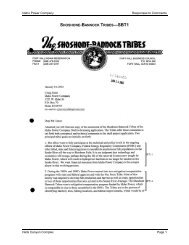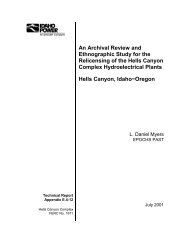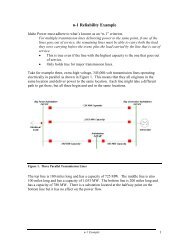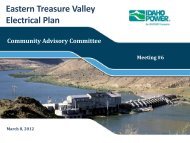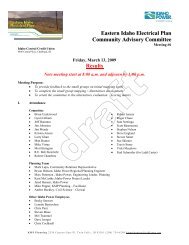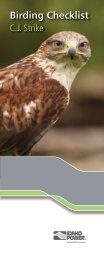Assessment of Chukar and Gray Partridge Populations - Idaho Power
Assessment of Chukar and Gray Partridge Populations - Idaho Power
Assessment of Chukar and Gray Partridge Populations - Idaho Power
- No tags were found...
You also want an ePaper? Increase the reach of your titles
YUMPU automatically turns print PDFs into web optimized ePapers that Google loves.
Hells Canyon <strong>Chukar</strong> <strong>and</strong> <strong>Gray</strong> <strong>Partridge</strong> Report, Ratti <strong>and</strong> Giudice 38Salmon River suggested that relative use <strong>of</strong> star thistle was lower than use <strong>of</strong> other habitats in1993-95; however, weather may explain more <strong>of</strong> the annual variation in chukar numbers thanrange expansion <strong>of</strong> star thistle, especially considering data from 1997 <strong>and</strong> 1999 (i.e., where 23<strong>and</strong> 45% <strong>of</strong> chukar observations were in star thistle, respectively) (C. Johnson, Bureau <strong>of</strong> L<strong>and</strong>Management, Cottonwood Resource Area, ID, personal communication).Medusahead, another introduced annual, is extremely competitive <strong>and</strong> can out competecheatgrass in degraded grassl<strong>and</strong>s (Hironaka et al. 1983, Franklin <strong>and</strong> Dyrness 1973). Westernrangel<strong>and</strong>s infested with medusahead have suffered 40-75% reductions in grazing capacity(Whitson et al. 1996:497). <strong>Chukar</strong>s readily ingest the caryopses <strong>of</strong> both medusahead <strong>and</strong>cheatgrass, but Savage et al. (1969) reported that captive birds fed downy brome (Bromustectorum) were in better condition than those fed medusahead. Thus, expansion <strong>of</strong> yellow-starthistle <strong>and</strong> medusahead <strong>and</strong> the subsequent decline in cheatgrass may pose a long-term threat insome areas currently inhabited by chukars (Walter 2000). However, more <strong>and</strong> better data areneeded to adequately evaluate the relative importance <strong>of</strong> habitat degradation (via yellow-starthistle <strong>and</strong> medusahead) <strong>and</strong> weather on chukar populations in the Intermountain West.4.10.6.2. <strong>Gray</strong> <strong>Partridge</strong>. Most gray partridge populations are closely associatedwith agricultural ecosystems; thus, they are affected by agricultural practices (Carroll 1993). InEurope, agricultural activities, including removal <strong>of</strong> hedgerow nesting cover, increased use <strong>of</strong>pesticides, <strong>and</strong> irrigation activities in cereal crops used for nesting, have negatively affected graypartridge populations (Potts 1980, 1986; R<strong>and</strong>s 1986, Birkan et al. 1990). Detailed studies inGreat Britain indicated that nest success was density dependent (a function <strong>of</strong> habitat availability<strong>and</strong> predator levels), while chick mortality, influenced by pesticide use <strong>and</strong> abundance <strong>of</strong>invertebrates during summers, was density independent (Potts 1986:182-186). In NorthAmerica, much less is known about impacts <strong>of</strong> different farming techniques on gray partridge(Carroll 1993). However, availability <strong>of</strong> permanent nesting cover has been reported to limitpopulations in North America (Hupp et al. 1980, Church 1984, Carroll et al. 1990), including thePalouse Prairie (Knott et al. 1943, Poelker <strong>and</strong> Buss 1972, Mendel 1979, Rotella et al. 1996). Onthe other h<strong>and</strong>, increases in some agricultural activities may have benefited partridge populationson the Palouse Prairie; e.g., fall-planted wheat fields provide better nesting cover than springplantedwheat fields <strong>and</strong> may provide nesting habitat for a small portion <strong>of</strong> the population(Rotella et al. 1996). However, these factors may not be as important for gray partridgeinhabiting mountainous areas such as Hells Canyon. For example, given the extensive grassl<strong>and</strong><strong>and</strong> shrub-steppe habitats in Hells Canyon, nesting cover may not be limiting, althoughquantitative data on habitat use are lacking. In general, effects from invasions <strong>of</strong> noxious weedson the gray partridge population inhabiting Hells Canyon are unknown.4.11. Conservation <strong>and</strong> Management4.11.1. <strong>Chukar</strong>The principal human effect on chukar populations is hunting, which can becontrolled through proper regulation (Christensen 1996). Estimated harvest rates <strong>of</strong> mostpopulations are substantially below the maximum-allowable rate <strong>of</strong> 40% recommended byMolini (1976; also see 4.10.4 Hunting, above). Thus, most chukar populations are probably



